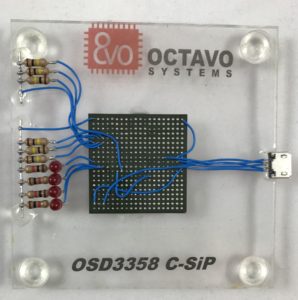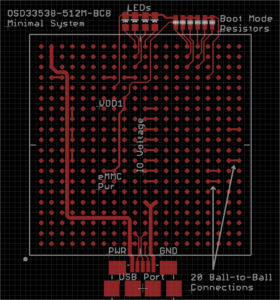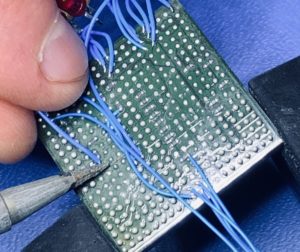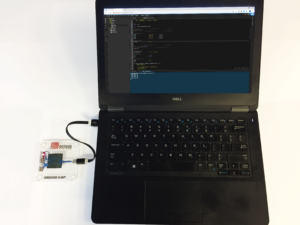
Erik Welsh
Applications & Systems Manager
Posted on April, 12, 2019
Categories
Recent Posts
- Octavo Systems Unveils the OSD32MP2 Series: Revolutionizing System Design in the Electronics Industry April 9, 2024
- Securing the Future: The Integral Role of SiP Technology in Thwarting Physical Attack Vectors in Embedded Systems March 12, 2024
- Developing Secure Embedded Systems: Best Practices and Strategies March 12, 2024
- Heterogeneous Integration (HI) and System-in-Package (SiP) Technology: A Comprehensive Overview February 20, 2024
- Understanding The Differences Between System-on-Chip (SoC), Package-on-Package (PoP), System-on-Module (SoM), and System-in-Package (SiP) January 17, 2024
OSD335x C-SiP Brings a Dead Bug Single Chip Computer to Life

Are you tired of spending all your time re-inventing the wheel? Unfortunately, many embedded engineers do just that; spend countless hours integrating the same core systems components over and over again. The OSD335x C-SiP allows you to break the cycle by providing an easy to use, complete system in a single package that integrates all of the core components that you need for your embedded system. Provide power, connect your peripherals, and you are ready to go. This single chip computer is so easy to use, you can now ‘dead bug’ a 1GHz Linux computer.
OSD335x C-SiP A Complete Linux System in Package
Dead bug prototyping (sometimes called freeform electronics) is a way of putting together a functioning electronic circuit by soldering the parts directly together or through wires instead of the traditional way of using a Printed Circuit Board (PCB). Typical dead bug designs use a simple microcontroller, preferably one with a “DIP” or “QFP” package with only few pins and easy to connect to wires.
More complex microprocessor dead bug designs are nearly impossible given the number of connections and high-speed busses required to connect a CPU, DDR memory, power management and non-volatile storage. The OSD335x C-SiP, a complete Linux system in package, makes the impossible possible. It packs everything needed for a powerful computing platform into a single BGA package that is only 27mm on a side. Inside the SiP is a 1GHz powerful Texas Instruments Sitara AM335x Cortex A8 CPU along with memory, power circuitry, oscillator and over 100 passives. With almost no external components, the OSD335x C-SiP is essentially a 1GHz single chip computer that supports multiple operating systems and has a large open source software community support.
OSD335x C-SiP Designed for Easy Layout
Turning the OSD335x C-SiP into a dead bug design is a fun way to demonstrate how easy it is to incorporate a microprocessor into your next embedded design. The OSD335x C-SiP is a perfect candidate to expand the world of dead bug design from microcontrollers to microprocessors as well as to simplify your next product. Even though, the OSD335x C-SiP is a BGA, it has a large, easy to solder 1.27mm (50 mil) ball pitch. Additionally, the ball maps of our System-in-Package devices are specifically designed from a system integration point of view. By moving all signal pins to the outer three rows and columns, it allows all signals to be escaped in one PCB layer with very standard 0.15mm (6 mil) trace / space routing rules.

Inspired by these and other ease of use layout features of the OSD335x C-SiP , and several projects out in the community, we decided to bring a ‘dead-bug’ to life! We built one to show at the recent Embedded World conference. Thank you to Hackaday for covering out story. We hope to inspire some entries into their next circuit sculpture contest with a more advanced application.
Download The Design Files and Follow the Instructions to Build Your Own Dead Bug Linux Computer
You can download the schematics and layout and then head on over to our Hackster page that walks through the construction of a simple dead bug system. Now, the only thing between you and your next microprocessor dead bug design is a steady hand!

Resources To Shorten Design Time with OSD335x C-SiP
The goal of our System in Package technology is to create modular building blocks that abstract away tedious, repetitive, and complex tasks that designers are forced to spend time on, but don’t really add value to the end system so that they can create better, more innovate products. To make designing with the OSD335x C-SiP fast, schematic symbol libraries are available now in Eagle, Altium and OrCad. We have a complete reference design for you to use, the OSD3358-SM-RED which is the Octavo Systems Reference, Evaluation, and Development board. We’ve also written a layout guide and a tutorial stepping through the design process to get C-SiP, the single chip computer, working for you.
Our system and applications team is readily available to help designers with design and layout questions. Connect directly with our applications engineers using our forums, it’s like having them standing at your side. *Special thanks to Mike Conti for his fantastic soldering capabilities.
For updates please sign up for our mailing list or follow us on Facebook, Twitter, or Linked In

